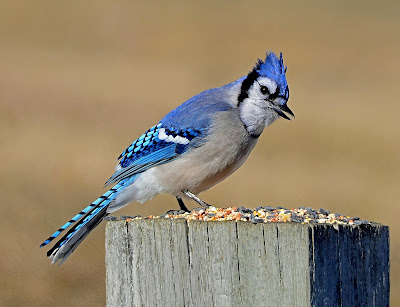Yellow-bellied sapsuckers
Nature News: Yellow-bellied sapsuckers really have yellow bellies
Published May 22 2019 seacoastonline.com/Portsmouth Herald/the York Weekly/Fosters Daily
 |
| Female yellow-bellied sapsucker lacks red throat. Sue Pike photo |
I love yellow-bellied sapsuckers (Sphyrapicus varius) for many reasons - their name, their personality, the interesting way they forage. What a terrific name - sounds like a cartoon character or a comical insult. If you get a chance to see their belly, you’ll see that it is, in fact, yellow. Technically they should be called saplickers not sapsuckers - they lick sap with their tongues, which are tipped with specialized brush-like structures. Like downy and hairy woodpeckers they have heavy black and white striping, but unlike downies and hairies which just have a patch of red on the back of their head, male sapsuckers have a bright red forehead and throat. Females lack the red throat patch.
Yellow-bellied sapsuckers have a unique method of feeding. In the early spring they drill round, deep holes to access the xylem (the vascular system of a tree that carries water, sugars and minerals upward in a tree) and then stick their bills into the holes to probe for sap. Later in the spring, after trees leaf out, they shift their approach to excavating shallow, rectangular holes to get at the more superficial phloem (the part of the vascular system that distributes sugars made during photosynthesis throughout the tree - usually higher in sugar content than the xylem). Unlike the deep, round sapwells, these shallow ones need to be maintained to keep the sap flowing. They usually drill sapwells in horizontal lines along the tree trunk, with new sapwells drilled just above the old ones. They concentrate on trees with high sugar content in their sap - birch, maple and apples. One apple tree in my yard has a trunk riddled with hundreds of sapwells, all arranged in neat rows up and down the trunk.
 |
| Male yellow-bellied sapsucker with red throat Sue Pike photo |
The sapsuckers don’t just lick the sap, they’ll also eat the cambium (the growth tissue of a tree) and any insects that are attracted to the sap (they love ants in particular). They also forage in more “normal” ways as well - flying out to take insects on wing, probing under loose bark and eating a variety of seeds and nuts when in season. They will also visit feeders for suet.
I had a group of 4 sapsuckers feeding at my suet feeder a few weeks ago, they’ve since moved on. I think of sapsuckers as noisy, inquisitive birds - more so than the downies and hairy woodpeckers that also visit my feeder. But this might just be because I typically see them most often in breeding season when they come to the suet feeder. The 4 sapsuckers hanging out at my suet feeder were very loud - I could hear them in the woods making their distinctive territorial call (described as a loud queee-ah, queee-ah), and at the feeder they chased each other and fluffed their feathers out at each other while raising their crests. This is all part of their courtship behavior. They didn’t always dart to the other side of the tree when they saw me watching but would often stay on the branch and watch me back. I’m sure they don’t really have friendly intentions, but it felt that way to me.
It has gotten quiet since they left. I like to think they’ve moved on to the serious business of nest building and child-rearing in a snag (a dead standing tree) deep in the forest behind the house.
Susan Pike, a researcher and an environmental sciences and biology teacher at St. Thomas Aquinas High School, welcomes your ideas for future column topics. She may be reached at spike3116@gmail.com. Read more of her Nature News columns online.



Comments
Post a Comment